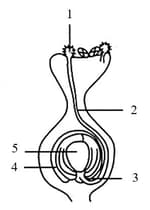Bindu wants to produce a hybrid variety of tomatoes. She has tomato plants X and Y belonging to two different varieties, one with smooth, long fruits and the other one with wrinkled, round fruits.
Tomatoes have bisexual flowers. Bindu carries out the following steps carefully to cross pollinate the flowers of plants X and Y:
1. She removes a part of the flowers of tomato plant X just before the flowers bloom.
2. She manually pollinates the flowers of tomato plant X using pollen from the flowers of tomato plant Y.
3. She ties small plastic bags around the pollinated flowers of tomato plant X. The plastic bags are removed after a couple of days.
Bindu carried out step 1 so as to prevent self-pollination. Which part did she remove?
Tomatoes have bisexual flowers. Bindu carries out the following steps carefully to cross pollinate the flowers of plants X and Y:
1. She removes a part of the flowers of tomato plant X just before the flowers bloom.
2. She manually pollinates the flowers of tomato plant X using pollen from the flowers of tomato plant Y.
3. She ties small plastic bags around the pollinated flowers of tomato plant X. The plastic bags are removed after a couple of days.

Important Questions on How do Organisms Reproduce?
The diagram shows the cross-section through the carpel of a flower just before fertilisation.
Where will the male and female gametes be just before fertilisation?
| Male gamete | Female gamete | |
| (a) | 1 | 5 |
| (b) | 1 | 4 |
| (c) | 2 | 4 |
| (d) | 3 | 5 |
The two glands A and B which occur in pairs are present in the endocrine system of humans. The pair of glands A is found only in females whereas the pair of glands B occurs only in males. The glands A make and secrete two hormones C and D whereas glands B make and secrete only one hormone E. In addition to hormones, glands A make gametes F whereas glands B make gametes G.
What are gametes (i) F, and (ii) G?
The factors responsible for the rapid spreading of bread mould on slices of bread are
(i) presence of a large number of spores in air.
(ii) presence of a large number of thread-like branched hyphae.
(iii) presence of moisture and nutrients.
(iv) formation of round shaped sporangia.

